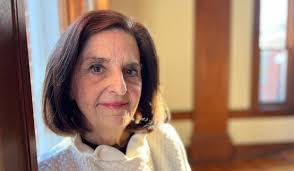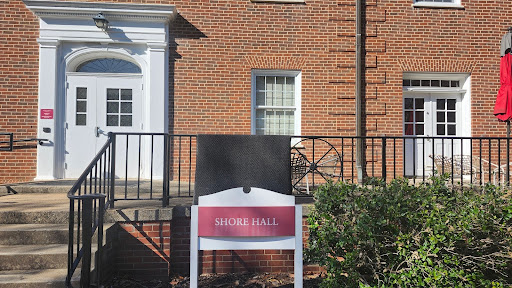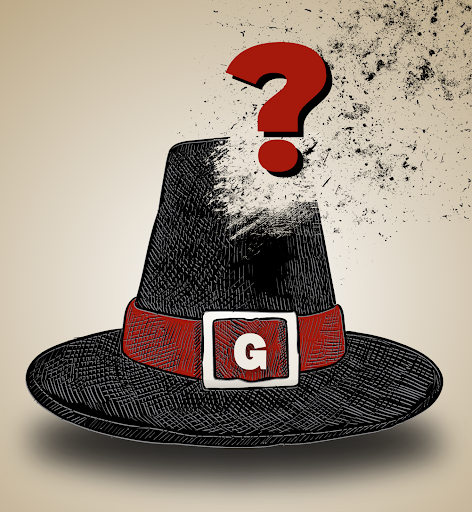Just when you thought it was safe to go to the Guilford Undergraduate Symposium, GUS 2012 arrived with more zombies, fairy tales and child-eating allegories than ever before.
Described as “a perfect incubator for ideas and designs” by organizer and co-founder Melanie Lee-Brown, associate professor of biology, the fifth annual GUS featured nearly 100 presentations ranging from CCE student AnneMarie Dickey’s “Creationism in Public Schools” to senior Sarah Schardt’s “‘It’s a Small World’: A Postcolonial Look at Disney’s ‘Magical Kingdom’” to senior Danielle Knight’s “Relating Age with Emoticons and Acronyms.” With so many presentations, it would be difficult not to find something to strike one’s fancy.
This year’s GUS teemed with life … or perhaps, un-life.
For those interested in the undead, there was the panel, “The Quick & The Undead.” Using the novel “World War Z,” television series “The Walking Dead,” films Night of the “Living Dead” and “Zombieland” and much more, the panel — composed of students of an English capstone class — offered a new perspective on on these classic monsters.
“We looked at zombies as representative of a cultural phenomenon and how they can represent different cultural anxieties we have or different issues that we have,” said senior Kelly McGregor. “We looked at zombies as representative of racism or classism, or our cultural issues with having a sense of community versus isolationism.”
For those looking to find a more fantastical side of academia, there was senior Alan Wildfeuer’s “Fairy Tales and Their Inner Meanings,” which delved into an analysis of the purpose of fairy tales.
This presentation came from Wildfeuer’s thesis on the same topic and the role of fairy tales in German literature. However, the presentation’s inspiration stemmed from a childhood saturated with stories and fantasy.
Wildfeuer encouraged the audience to find a “different understanding of fairy tales” and to “see that there is some meaning and intention behind (fairy tales) and also that they can have a role in society.”
GUS also showed the more artistic side of Guilford. Resting atop a wooden book shelf in the Carnegie Room was box of wood-carving tools, blocks used for printing and, of course, artistic prints. Senior Jack Arthur Wood Jr. presented three printed original works of art in his presentation “Intricacy, Religion, and Obsession in Relief Printmaking.”
One of Wood’s prints was based on Moloch from Alan Ginsberg’s poem “Howl.”
“Moloch eats children or burns children and he’s an allegory of the American nightmare of industrial hell,” said Wood.
In the abstract printed in the schedule, Wood describes his work, saying, “My objective is to illustrate the horror of reality through vandalism of the divine.”
Beyond language and the arts, Guilford students also presented work relating to science. For example, Early College students Kiel Williams and Jeremy Chang explained their work in their presentation “Bringing Science Into The Community: Physics Department Outreach at Jefferson Elementary.”
In this presentation, Williams and Chang shared their experiences visiting and working with Jefferson Elementary School and teaching children simple physics.
Guilford students introduced elementary school children to the assembly and use of telescopes, as well as the use of low-powered lasers and their interaction with mirrors.
This is not the first time Guilford students have shared their knowledge with these children, nor will it likely be the last.
“I hope someone else will be motivated to go out, whatever their area of expertise is, whether they’re sociologists or biologist or historians,” said Williams. “They have something interesting they can offer to students.”
This is very similar to what Lee-Brown and organizer and co-founder Rob Whitnell, professor of chemistry, hoped for and have accomplished through GUS.
Through these diverse presentations, the hidden lives and studies of Guilford students come out. At GUS, every student has the opportunity to be a teacher.
“It really brings together all the different components of the academic program on one day and really encourages both students and faculty to learn so much more about what we do and what is really at the core of the mission of the college,” said Whitnell.
“It’s about learning about each other and pulling us together, giving us a venue for somebody to present their ideas,” said Lee-Brown. “When you start to put that up to people from other disciplines, next thing you know you start getting different ideas coming in or another viewpoint, and we can continue to build on that which is really the core for us at Guilford.”
GUS has also helped stir interest in students to become more involved.
After hearing the Guilford Chamber Choir perform, freshman Olivia Tibbs said, “I can’t wait to try to be in there next year.”
Though the Guilfordian can only feature a few presentations, GUS was a menagerie of academia with countless presentations opening doors to a wide array of disciplines, including political science, physics, English, German, religious studies, music, art, creative writing, and more.
Next year, even you could have your voice heard.











